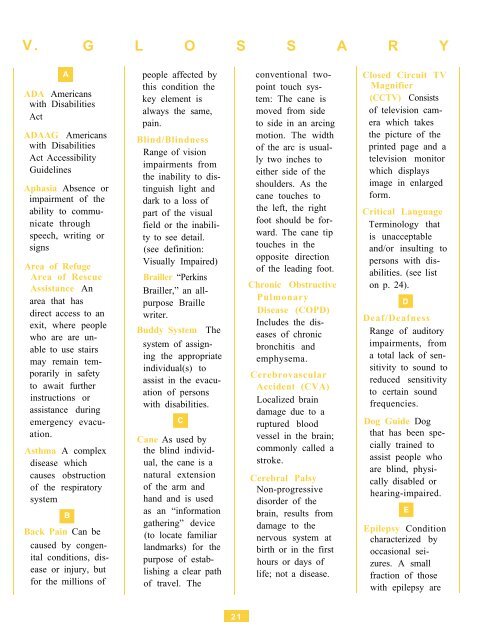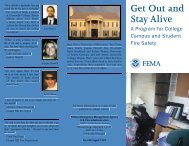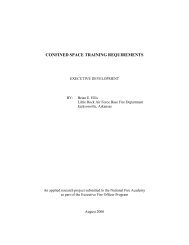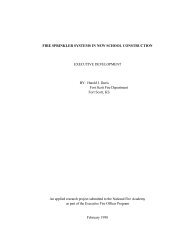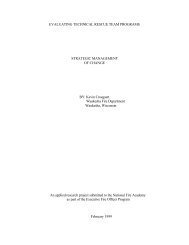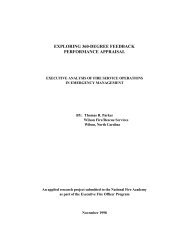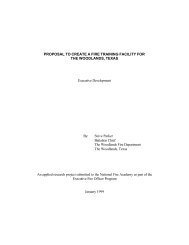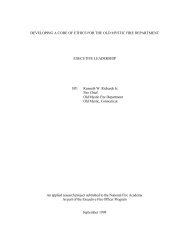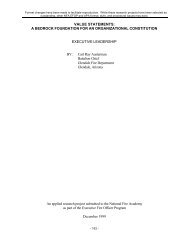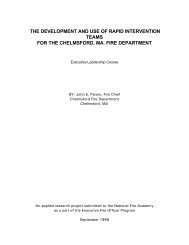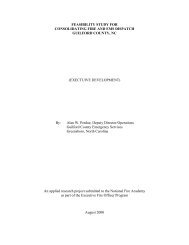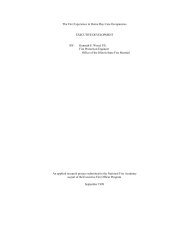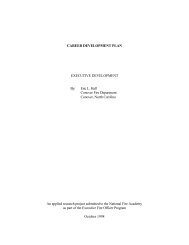Emergency Procedures for Employees with Disabilities - US Fire ...
Emergency Procedures for Employees with Disabilities - US Fire ...
Emergency Procedures for Employees with Disabilities - US Fire ...
You also want an ePaper? Increase the reach of your titles
YUMPU automatically turns print PDFs into web optimized ePapers that Google loves.
V. G L O S S A R Y<br />
A<br />
ADA Americans<br />
<strong>with</strong> <strong>Disabilities</strong><br />
Act<br />
ADAAG Americans<br />
<strong>with</strong> <strong>Disabilities</strong><br />
Act Accessibility<br />
Guidelines<br />
Aphasia Absence or<br />
impairment of the<br />
ability to communicate<br />
through<br />
speech, writing or<br />
signs<br />
Area of Refuge<br />
Area of Rescue<br />
Assistance An<br />
area that has<br />
direct access to an<br />
exit, where people<br />
who are are unable<br />
to use stairs<br />
may remain temporarily<br />
in safety<br />
to await further<br />
instructions or<br />
assistance during<br />
emergency evacuation.<br />
Asthma A complex<br />
disease which<br />
causes obstruction<br />
of the respiratory<br />
system<br />
B<br />
Back Pain Can be<br />
caused by congenital<br />
conditions, disease<br />
or injury, but<br />
<strong>for</strong> the millions of<br />
people affected by<br />
this condition the<br />
key element is<br />
always the same,<br />
pain.<br />
Blind/Blindness<br />
Range of vision<br />
impairments from<br />
the inability to distinguish<br />
light and<br />
dark to a loss of<br />
part of the visual<br />
field or the inability<br />
to see detail.<br />
(see definition:<br />
Visually Impaired)<br />
Brailler “Perkins<br />
Brailler,” an allpurpose<br />
Braille<br />
writer.<br />
Buddy System The<br />
system of assigning<br />
the appropriate<br />
individual(s) to<br />
assist in the evacuation<br />
of persons<br />
<strong>with</strong> disabilities.<br />
C<br />
Cane As used by<br />
the blind individual,<br />
the cane is a<br />
natural extension<br />
of the arm and<br />
hand and is used<br />
as an “in<strong>for</strong>mation<br />
gathering” device<br />
(to locate familiar<br />
landmarks) <strong>for</strong> the<br />
purpose of establishing<br />
a clear path<br />
of travel. The<br />
21<br />
conventional twopoint<br />
touch system:<br />
The cane is<br />
moved from side<br />
to side in an arcing<br />
motion. The width<br />
of the arc is usually<br />
two inches to<br />
either side of the<br />
shoulders. As the<br />
cane touches to<br />
the left, the right<br />
foot should be <strong>for</strong>ward.<br />
The cane tip<br />
touches in the<br />
opposite direction<br />
of the leading foot.<br />
Chronic Obstructive<br />
Pulmonary<br />
Disease (COPD)<br />
Includes the diseases<br />
of chronic<br />
bronchitis and<br />
emphysema.<br />
Cerebrovascular<br />
Accident (CVA)<br />
Localized brain<br />
damage due to a<br />
ruptured blood<br />
vessel in the brain;<br />
commonly called a<br />
stroke.<br />
Cerebral Palsy<br />
Non-progressive<br />
disorder of the<br />
brain, results from<br />
damage to the<br />
nervous system at<br />
birth or in the first<br />
hours or days of<br />
life; not a disease.<br />
Closed Circuit TV<br />
Magnifier<br />
(CCTV) Consists<br />
of television camera<br />
which takes<br />
the picture of the<br />
printed page and a<br />
television monitor<br />
which displays<br />
image in enlarged<br />
<strong>for</strong>m.<br />
Critical Language<br />
Terminology that<br />
is unacceptable<br />
and/or insulting to<br />
persons <strong>with</strong> disabilities.<br />
(see list<br />
on p. 24).<br />
D<br />
Deaf/Deafness<br />
Range of auditory<br />
impairments, from<br />
a total lack of sensitivity<br />
to sound to<br />
reduced sensitivity<br />
to certain sound<br />
frequencies.<br />
Dog Guide Dog<br />
that has been specially<br />
trained to<br />
assist people who<br />
are blind, physically<br />
disabled or<br />
hearing-impaired.<br />
E<br />
Epilepsy Condition<br />
characterized by<br />
occasional seizures.<br />
A small<br />
fraction of those<br />
<strong>with</strong> epilepsy are


